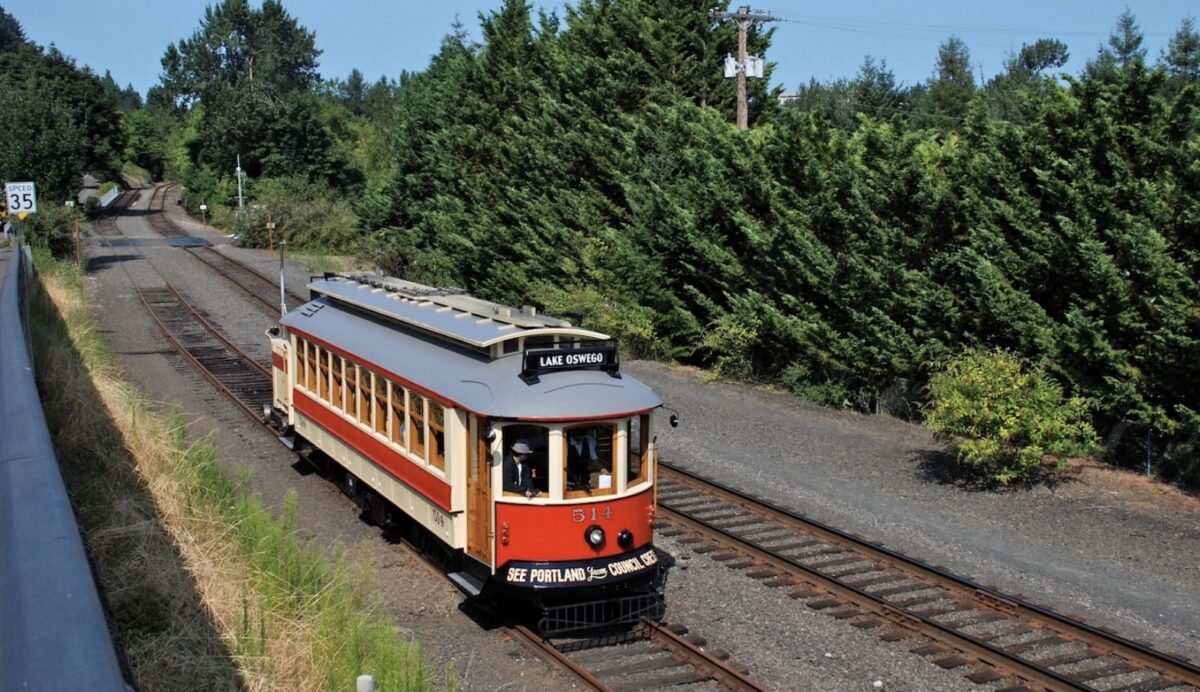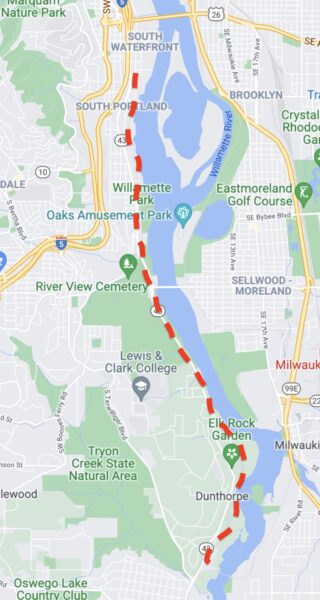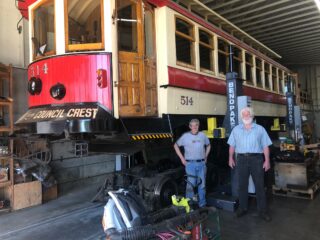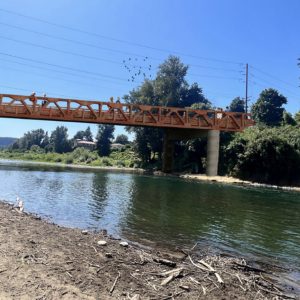
(Photo: Steve Morgan/Wikimedia Commons)
10 years after hopes for a new streetcar line to Lake Oswego were dashed, the Willamette Shore Trolley line is showing signs of new life. The line, which has very limited and seasonal service, takes passengers on a scenic excursion in a vintage replica trolley from Portland’s South Waterfront to Lake Oswego, and serves as a popular weekend outing for tourists and families.

(Photo: Jonathan Maus/BikePortland)
But advocates see this rail line as more than just a tourist activity. The Willamette Shore Trolley runs on a track built in the late 1800s that was used most often during the 1920s, when the old electric interurban rail system in the Willamette Valley served as the freeway. This short trip from Portland to Lake Oswego represents a dream of revitalized train travel in the Pacific Northwest as an alternative to highway expansion and many bike lovers haven’t given up on the dream of an adjacent bike path.
“We had an incredible network of rail service and it’s all gone,” says Rick Gustafson, veteran rail advocate, former director of Portland Streetcar and current president of Vintage Trolley Incorporated, the company that owns the trolleys.
But Gustafson and Dave Rowe, the WST’s superintendent of vehicle maintenance, see the golden era of Oregon’s intercity transit as something that could happen again.
“A million-and-a-half passengers moved by rail in Oregon annually back then. You could ride rail anywhere up and down the Willamette Valley,” Rowe says. “The Willamette Shore Trolley is a short line, but the idea is that the rail right-of-way is still there.”
“America is so far behind. I wish that we’d get our politicians to look at this so we could fund it.”
— Dave Rowe, Willamette Shore Trolley
In the 1980s, after passenger rail hadn’t been running on this line for decades, a consortium of public entities that included the City of Portland, the City of Lake Oswego and TriMet purchased the right-of-way to the track that the Willamette Shores Trolley runs on. This secured the line the seasonal excursion and for potential future use.
Unfortunately damaged trestle bridges have forced the trolley to run only on the southern portion of its track, from just north of Lake Oswego to the Elk Rock tunnel. Rowe and others with WST are hopeful that money from Biden Infrastructure Investment and Jobs Act will go toward these repairs so service can be re-established all the way to South Waterfront in Portland.
It will take a minimum of $800,000 to update the trestles to necessary safety standards, restoring the full route and bringing it back to its status as a unique tourist attraction and important piece of rail preservation that could herald future mass transit.
Advertisement

Since the line the WST runs on is so old and needs so many repairs, some advocates have proposed establishing a bike and pedestrian path over the railroad tracks. This has long been a dream of regional bike advocates. In 2006 The Street Trust (then Bicycle Transportation Alliance) made a Portland to Lake Oswego bike path one of their top priorities. In 2015, the Lake Oswego City Council revived the concept of a bike path along the trolley right-of-way. A bikeway running alongside the tracks wouldn’t be feasible along the whole line, like in the narrow Elk Rock tunnel, so the route might have to detour onto roadway shoulders in certain spots.
If the WST doesn’t run passenger trains, part of the right-of-way will be given back to the property owners who live along the rail lines, making it much more difficult to restore any kind of commuter service between Lake Oswego and Portland in the future. Gustafson says retaining the right-of-way could provide opportunities for other solutions in the future that could accommodate both bike and trolley travel, and he sees the door open for further discussions on this down the line.
Rowe is also considering how to allow passengers to take bikes on the trolley, potentially by adding a bike rack that could serve as an alternative to a bikeway.
Meanwhile, Rowe has also been working on converting one of the diesel trolley cars to battery power, with hopes to electrify the whole system and a nod toward restoring the century-old legacy of the first battery-operated streetcar line in the Western U.S. This will make it more environmentally friendly, less expensive to run and easier on neighbors’ ears. He hopes the battery-powered trolley car might be operable by this summer to test on the shorter track.

(Photo: Dave Rowe)
Ultimately, rail activists hope that rail service can serve as an alternative to freeway expansion.
Members of the Association of Oregon Rail and Transit Advocates (AORTA) have taken a strong stance for intercity passenger rail services and have especially made this position clear in the face of the proposed I-5 Rose Quarter and Interstate Bridge expansion projects.
“Transportation has to be a service that is provided to the citizens,” Rowe says. He points to high-speed rail systems in China and electric rail in Germany as examples of what we could aspire to. “America is so far behind. I wish that we’d get our politicians to look at this so we could fund it.”






Thanks for reading.
BikePortland has served this community with independent community journalism since 2005. We rely on subscriptions from readers like you to survive. Your financial support is vital in keeping this valuable resource alive and well.
Please subscribe today to strengthen and expand our work.
What a great project idea. I hope they get the funds to fix up and extend the route. I’d love rail travel to become more of a commuter factor in the region. There are 100,000 autos/trucks a day traveling through the I-5 RQ area so there is a ways to go before it makes a dent, unfortunately.
I hope there are bike racks on the trolley, but I can’t imagine this would be “an alternative to a bikeway” unless these trolleys are running WAY more often than I expect them to be.
If Portland and Lake Oswego are still behind this project then that’s great (the references are from several years back) but there are a LOT of wealthy property owners along this line who are probably not going to be convinced by “it’s battery-operated now” arguments. If this is going to happen it’s going to be a fight. I’m all for it though.
More campsites for Portlanders. It will be an extreme uphill battle.
I’d say let’s give up on any plans for new paths until we can figure out how to get our current ones under control.
I hope the powers-that-be look at a future streetcar extension down that corridor in the future … but that they come up with a better plan than the sluggish, overpriced boondoggle that we saw the last time around.
For now, I look forward to riding the battery-powered vintage streetcars.
As much as I support rail transit, this is an anachronism, IMO a multiuse trail would be a better use of the ROW. Best solution would be to piggyback one on the other w/o detours onto arterial streets. This would mean cyclists and trains would have to share trestles. I don’t see any problem since trains won’t be that frequent. Just lay a cycling-friendly roadbed between the rails.
I’d say the best use of ROW is probably an actual rapid transit project. But a multi use path would probably provide more utility, and be less expensive than a battery powered trolley
To update the historical text:
“A million-and-a-half passengers moved by rail in Oregon annually back then. You could ride rail anywhere along the Willamette Valley […and as far north as Vancouver WA]”
What about this supplemental tourism idea:
– establish a “rail bike” rental service to operate on the rails in the off hours / off season?
This should seriously be used for a streetcar expansion to Lake Oswego. The entire right of way is already publicly owned so it would be much more affordable than other potential transit projects. A bike trail would be nice, sure, but we shouldn’t remove the potential for mass transit to make it happen.
There are a dozen routes on the east side, especially east-west, that would serve 10x more people, all along properties whose redevelopment potential would benefit from a streetcar.
Also, since most streetcar routes are almost all in streets, those are also already publicly owned (not all the L.O. trolley line is publicly owned).
At the major public meeting for the L.O. streetcar a few years ago, there were literally only two people I remember speaking who actually said they’d use it–a Blazers season ticket holder, and a guy who wanted to be able to go to restaurants in NW instead of LO without driving–basically two guys who didn’t want to drive at night, or take a bus or ride service.
The LO-to-downtown Portland commute is also one of the few anywhere where drivers can speed the whole way.
I’d love a bike route on the line, but I wouldn’t give it a high priority when people are dying regularly trying to walk in East Portland due to lack of basic sidewalks and crosswalks.
Come on, let’s not be naysayers to any improvements anywhere until somewhere else meets your definition of “equity”. This a surefire way to stagnation and “status quo”.
It’s common sense to spend money first where it’s needed the most.
We shouldn’t be dropping millions on high-capacity transit to a wealthy, low-ridership suburb when there are thousands of low-income Portlanders in east Portland who don’t even have access to frequent bus service.
Looks cool. We need anything we can get right now to bring back some tourists to Portland. Adding bike transport would be super cool.
The current rail bed and tunnel are perfectly rideable in either direction right now. Down to Riverwood Dr. or up from there.
Sure on a carbon road race bike on 25’s maybe not very fun but a set of 35’s and a headlight… Bob’s Your Uncle.
Bike racks on the trolley? Give me a break. That’s a GWOT.
The trail is there now, ride it.
As far as this adding to camping. Not so sure about that. I mean if folks were going to camp along the current rail bed. It would already be happening. There isn’t camping now because there isn’t access to services i.e. drug delivery. Plus these neighborhoods have private security patrols too. It’s remote. Same reason folks aren’t camping along the CZ or BVT. There are no services that cater to camping.
A larger trail or bike path conversion isn’t happening because the residents want that right away and don’t want anyone in their neighborhoods. Seems to me that a bike path might be way better than a trolley wiz’ing by your house. Might also add to home values?
Astoria had a very low-tech version of electrification of their waterfront trolly 20 years ago. They towed a generator. No wires and transformers required.
That’s how the Willamette Trolley has been operating for decades. I think they want to pursue a cleaner, quieter option. Given the short run and long dwell times at the depot, I think a battery-electric streetcar is entirely appropriate. No wires needed.
This was a long-awaited, great idea. I hope they will complete it soon
What if we converted the line to narrow gauge (or even miniature)? We could then maintain the right of way while making room for a trail.
Seriously doubt it will ever be a real form of transportation.
Lake O is the land of affluent privilege and there were objections in the past to any reuse of rail right of way. Part of the appeal is keeping the other 90% out.
See the case of lack of public access to lake. This is only allowed because of the strong influence of local lobbying.
https://www.opb.org/news/article/oregon-oswego-lake-access-supreme-court-decision-clackamas-county/